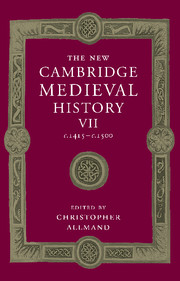Book contents
- Frontmatter
- PART I GOVERNMENT
- PART II ECONOMIC AND SOCIAL DEVELOPMENTS
- PART III SPIRITUAL, CULTURAL AND ARTISTIC LIFE
- 10 Religious Belief and Practice
- 11 Schools and Universities
- 12 Humanism
- 13 Manuscripts and Books
- 14 The Beginning of Printing
- 15 Architecture and Painting
- 16 Music
- PART IV THE DEVELOPMENT OF EUROPEAN STATES
- Appendix Genealogical Tables
- Primary Sources and Secondary Works Arranged by Chapter
- Index
- Frontispiece
- Plate section
- Map 1 European towns in the late Middle Ages
- Map 2 European commerce and trade
- Map 4 Winds and currents facilitating the discoveries
- Map 5 The universities o f Europe in 1400 and 1500
- Map 6 Germany and the Empire
- Map 20 The Roman Orthodox and Ottoman worlds in the fifteenth century
- References
14 - The Beginning of Printing
from PART III - SPIRITUAL, CULTURAL AND ARTISTIC LIFE
Published online by Cambridge University Press: 28 March 2008
- Frontmatter
- PART I GOVERNMENT
- PART II ECONOMIC AND SOCIAL DEVELOPMENTS
- PART III SPIRITUAL, CULTURAL AND ARTISTIC LIFE
- 10 Religious Belief and Practice
- 11 Schools and Universities
- 12 Humanism
- 13 Manuscripts and Books
- 14 The Beginning of Printing
- 15 Architecture and Painting
- 16 Music
- PART IV THE DEVELOPMENT OF EUROPEAN STATES
- Appendix Genealogical Tables
- Primary Sources and Secondary Works Arranged by Chapter
- Index
- Frontispiece
- Plate section
- Map 1 European towns in the late Middle Ages
- Map 2 European commerce and trade
- Map 4 Winds and currents facilitating the discoveries
- Map 5 The universities o f Europe in 1400 and 1500
- Map 6 Germany and the Empire
- Map 20 The Roman Orthodox and Ottoman worlds in the fifteenth century
- References
Summary
of all the changes witnessed by the fifteenth century, it is arguable that none has had so profound an effect as the invention of printing. For more than two thousand years, much of Europe had depended on the written word for at least some aspects of its activities, while the history of Christendom was (as it still remains) defined by a central religious written text, the Bible. In such a context, the advent of printing heralded changes that have rightly been described as revolutionary. But like all revolutions, the invention of printing, its subsequent course, its effects and the ways in which it was exploited, raise issues that have little to do with the more immediate circumstances of invention: the application of metallurgical, chemical, calligraphic and engraving skills to the production of a printed page.
The concept of multiple copies, identical in text and in format, was not new. In the ninth century, the monastery of Tours, among others, had specialised in the production of Bibles, exporting them to centres throughout the Carolingian Empire. In the thirteenth century, the needs of universities at Paris, Bologna and Oxford for identical teaching texts had been met by the so-called pecia system, whereby authorised copies of parts of books were lent out for copying – a process that, because it enabled several people to copy out the same book simultaneously, added considerably to speed of production as well as reducing (if far from eliminating) the opportunities for inaccuracy. In thirteenth- century Paris, the production of small Bibles, for private use, was organised on an unprecedented scale and with much consequent uniformity.
Keywords
- Type
- Chapter
- Information
- The New Cambridge Medieval History , pp. 287 - 298Publisher: Cambridge University PressPrint publication year: 1998

